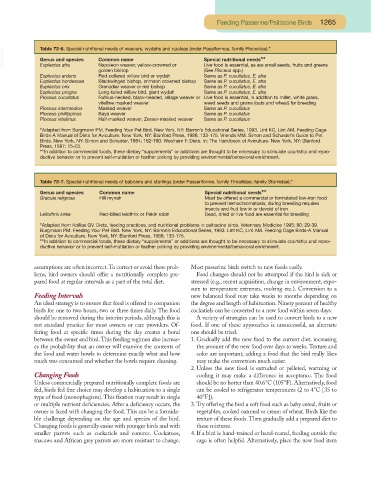Page 1215 - Small Animal Clinical Nutrition 5th Edition
P. 1215
Feeding Passerine/Psittacine Birds 1265
VetBooks.ir Table 72-6. Special nutritional needs of weavers, wydahs and queleas (order Passiformes, family Ploceidae).*
Special nutritional needs**
Common name
Genus and species
Euplectus afra
Napoleon weaver, yellow-crowned or
(See Ploceus spp.)
golden bishop Live food is essential, as are small seeds, fruits and greens
Euplectus ardens Red-collared willow bird or wydah Same as P. cucullatus, E. afra
Euplectus hordeacea Blackwinged bishop, crimson crowned bishop Same as P. cucullatus, E. afra
Euplectus orix Grenadier weaver or red bishop Same as P. cucullatus, E. afra
Euplectus progne Long-tailed willow bird, giant wydah Same as P. cucullatus, E. afra
Ploceus cucullatus Rufous-necked, black-headed, village weaver or Live food is essential, in addition to millet, white grass,
vitelline masked weaver weed seeds and grains (oats and wheat) for breeding
Ploceus intermedius Masked weaver Same as P. cucullatus
Ploceus phillippinus Baya weaver Same as P. cucullatus
Ploceus vitellinus Half-masked weaver, Zesser-masked weaver Same as P. cucullatus
*Adapted from Burgmann PM. Feeding Your Pet Bird. New York, NY: Barron’s Educational Series, 1993. Lint KC, Lint AM. Feeding Cage
Birds-A Manual of Diets for Aviculture. New York, NY: Blanford Press, 1988; 133-175. Vriends MM. Simon and Schuster’s Guide to Pet
Birds. New York, NY: Simon and Schuster, 1984; 182-190. Woolham F. Diets. In: The Handbook of Aviculture. New York, NY: Blanford
Press, 1987; 15-23.
**In addition to commercial foods, these dietary “supplements” or additions are thought to be necessary to stimulate courtship and repro-
ductive behavior or to prevent self-mutilation or feather picking by providing environmental/behavioral enrichment.
Table 72-7. Special nutritional needs of babblers and starlings (order Passeriforme, family Timaliidae, family Sturnidae).*
Genus and species Common name Special nutritional needs**
Gracula religiosa Hill mynah Must be offered a commercial or formulated low-iron food
to prevent hemochromatosis; during breeding requires
insects and fruit low in or devoid of iron
Leitothrix lutea Red-billed leiothrix or Pekin robin Dead, dried or live food are essential for breeding
*Adapted from Kollias GV. Diets, feeding practices, and nutritional problems in psittacine birds. Veterinary Medicine 1995; 90: 29-39.
Burgmann PM. Feeding Your Pet Bird. New York, NY: Barron’s Educational Series, 1993. Lint KC, Lint AM. Feeding Cage Birds-A Manual
of Diets for Aviculture. New York, NY: Blanford Press, 1988; 133-175.
**In addition to commercial foods, these dietary “supplements” or additions are thought to be necessary to stimulate courtship and repro-
ductive behavior or to prevent self-mutilation or feather picking by providing environmental/behavioral enrichment.
assumptions are often incorrect.To correct or avoid these prob- Most passerine birds switch to new foods easily.
lems, bird owners should offer a nutritionally complete pre- Food changes should not be attempted if the bird is sick or
pared food at regular intervals as a part of the total diet. stressed (e.g., recent acquisition, change in environment, expo-
sure to temperature extremes, molting etc.). Conversion to a
Feeding Intervals new balanced food may take weeks to months depending on
An ideal strategy is to ensure that food is offered to companion the degree and length of habituation. Ninety percent of healthy
birds for one to two hours, two or three times daily. The food cockatiels can be converted to a new food within seven days.
should be removed during the interim periods, although this is A variety of strategies can be used to convert birds to a new
not standard practice for most owners or care providers. Of- food. If one of these approaches is unsuccessful, an alternate
fering food at specific times during the day creates a bond one should be tried.
between the owner and bird.This feeding regimen also increas- 1. Gradually add the new food to the current diet, increasing
es the probability that an owner will examine the contents of the amount of the new food over days to weeks. Texture and
the food and water bowls to determine exactly what and how color are important; adding a food that the bird really likes
much was consumed and whether the bowls require cleaning. may make the conversion much easier.
2. Unless the new food is extruded or pelleted, warming or
Changing Foods cooling it may make a difference in acceptance. The food
Unless commercially prepared nutritionally complete foods are should be no hotter than 40.6°C (105°F). Alternatively, food
fed, birds fed free choice may develop a habituation to a single can be cooled to refrigerator temperatures (2 to 4°C [35 to
type of food (monophagism). This fixation may result in single 40°F]).
or multiple nutrient deficiencies. After a deficiency occurs, the 3. Try offering the bird a soft food such as baby cereal, fruits or
owner is faced with changing the food. This can be a formida- vegetables, cooked oatmeal or cream of wheat. Birds like the
ble challenge depending on the age and species of the bird. texture of these foods. Then gradually add a prepared diet to
Changing foods is generally easier with younger birds and with these mixtures.
smaller parrots such as cockatiels and conures. Cockatoos, 4. If a bird is hand-trained or hand-reared, feeding outside the
macaws and African grey parrots are more resistant to change. cage is often helpful. Alternatively, place the new food item

